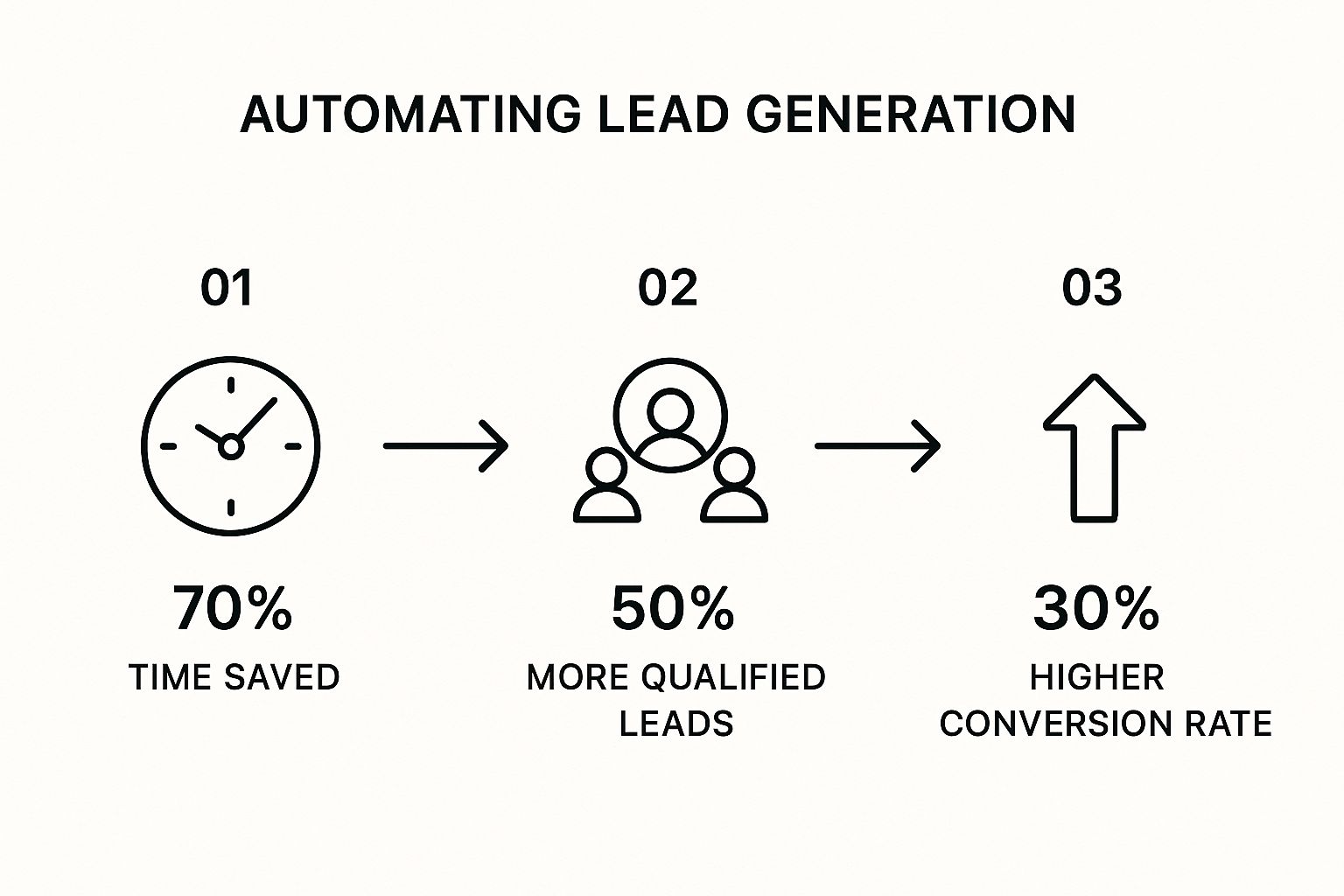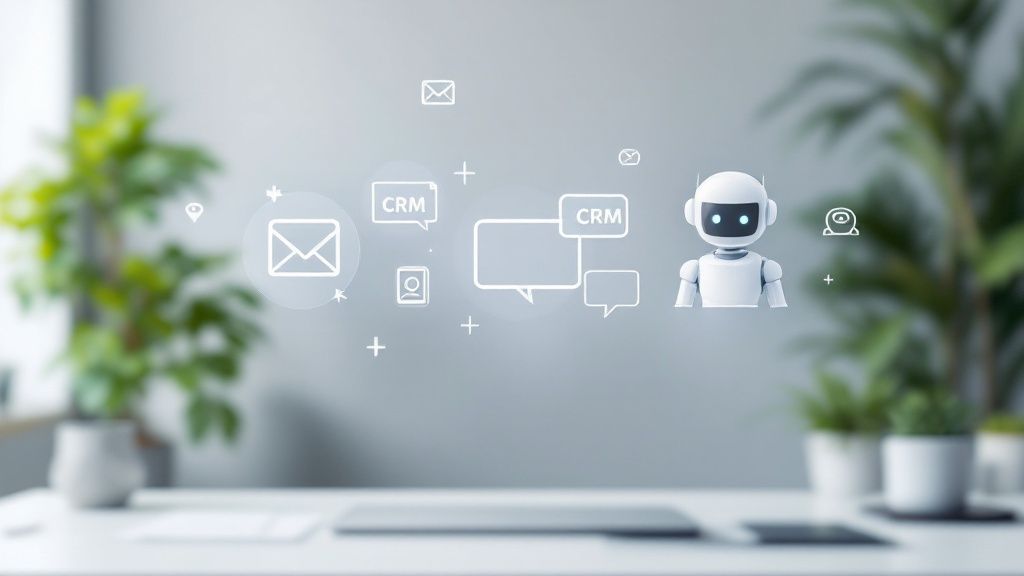Why Traditional Lead Generation Is Failing Modern Businesses

Today's business world requires companies to be nimble and efficient, especially when connecting with potential customers. Traditional lead generation tactics, often relying on manual processes like cold calling and generic email blasts, are falling short. These methods are time-consuming and increasingly ineffective in a marketplace overflowing with marketing messages. Think about the declining success of cold calling in a time of caller ID and spam filters.
Modern buyers are also more informed and selective. They research independently, engage with content on their terms, and expect personalized experiences. This shift in buyer behavior necessitates that businesses adjust their strategies and adopt more refined approaches to capturing and nurturing leads. Simply put, traditional methods often miss the mark in providing the personalized, value-driven interactions that today’s buyers seek.
The Rise of Automation as a Necessity
Automating lead generation is no longer just a beneficial option—it's crucial. Automation empowers businesses to effectively navigate these evolving market dynamics. It allows for personalized communication at scale, nurtures leads through automated workflows, and frees up sales teams to focus on relationship building and closing deals. It's like having a dedicated virtual assistant working around the clock to identify, qualify, and nurture leads.
The integration of Artificial Intelligence (AI) and automation in lead generation has become a key trend. Businesses are striving to overcome the challenges of a competitive market. By 2025, research indicates that a significant 79% of B2B marketers will be using AI-powered tools to automate lead generation, with 53% planning to invest further in these technologies to enhance campaign effectiveness. For more in-depth statistics, check out: Lead Automation Generation Strategies for 2025.
Overcoming Practical Challenges
Automation also directly tackles many practical challenges faced by marketing teams. Resource constraints, the difficulty of scaling outreach, and maintaining consistency across different channels can all be improved through automated systems. This allows businesses to reach a wider audience, deliver consistent messaging, and track performance more effectively, all while boosting efficiency.
For more insights, you might find this helpful: How to Master LinkedIn Automation for Lead Generation. This allows for more targeted and effective campaigns, maximizing ROI and contributing to sustainable growth. By automating repetitive tasks, businesses can prioritize strategy, creativity, and fostering valuable connections with potential customers. This shift from manual to automated processes is essential for businesses to succeed in today’s competitive market.
Building Your Automated Lead Machine: Essential Components
Effective automated lead generation isn't about spending money on the newest software. It's about constructing a system that works together smoothly. Think of it as building a well-oiled machine, where every part has a crucial job in attracting, engaging, and guiding potential customers toward a sale. This section explains the key elements that, when combined correctly, create a smooth experience for potential customers while also identifying the most promising leads for your sales team.
Essential Building Blocks of an Automated System
-
Lead Capture Forms: These are your system's entry points, often found on landing pages or within your content. They gather important contact information, serving as the first point of contact in the lead generation process.
-
Chatbots: These AI-powered assistants engage website visitors, answer their questions, and qualify leads around the clock. They offer instant interaction and collect valuable data.
-
CRM (Customer Relationship Management): This central hub stores and manages all your lead data. It allows for segmentation, tracking, and personalized communication—acting as the control center of your operations. HubSpot is a popular example.
-
Email Marketing Platform: This component automates email sequences, delivering targeted content and guiding leads through the sales funnel. It's your primary communication channel. Mailchimp is a widely used option.
-
Lead Scoring System: This system assigns values to leads based on their behavior and characteristics. This helps prioritize follow-up and allows sales teams to focus on the most promising opportunities.
Visualizing the Benefits
The infographic below shows how these interconnected parts drive results:

As the infographic shows, automating lead generation saves a significant amount of time (70%), which allows for improved lead qualification. This leads to 50% more qualified leads and contributes to a 30% rise in conversion rates, directly improving your profits. These gains come from the efficiency and targeted approach that automation makes possible. For a deeper look into effective B2B lead generation tactics, see also: How to Master B2B Sales Lead Generation.
To further illustrate the key components and their impact on return on investment (ROI), consider the following table:
Components of Automated Lead Generation Systems
This table outlines the core components of a comprehensive automated lead generation system, their primary functions, and implementation complexity.
| Component | Primary Function | Implementation Complexity | Typical ROI Timeline |
|---|---|---|---|
| Lead Capture Forms | Gathers contact information | Low | Immediate – Short Term |
| Chatbots | Engages visitors, qualifies leads | Medium | Short – Medium Term |
| CRM (Customer Relationship Management) | Stores and manages lead data | Medium | Short – Long Term |
| Email Marketing Platform | Automates email sequences, nurtures leads | Medium | Short – Medium Term |
| Lead Scoring System | Prioritizes leads based on behavior | Medium-High | Medium – Long Term |
As this table demonstrates, while some components offer a quicker ROI, a truly effective system requires the integration of all components for long-term, sustainable success. Lead capture forms, for instance, offer immediate value, while the full impact of a CRM or lead scoring system might take longer to realize.
Choosing the Right Tools: Avoiding Expensive Distractions
Many tools are available for each component, but they're not all equally effective. Some offer real value, while others can be expensive distractions. For example, a complex marketing automation platform may be too much for a small business, while a basic CRM might not offer the features needed by a larger enterprise.
Real-World Integration for Success
Successful companies carefully select and integrate these components to create a unified system. They understand that the real power of automation lies in how these elements work together. A well-integrated system captures leads from different channels, qualifies them based on set criteria, nurtures them with personalized messages, and seamlessly hands them off to the sales team at the right time. This ensures a smooth lead flow, reduces manual work, and maximizes the potential for conversions.
AI-Powered Lead Qualification: Beyond Basic Scoring

Traditional lead scoring methods often miss the mark. They rely on simplistic criteria that don't always reflect a lead's real potential. This can lead sales teams down a rabbit hole, chasing leads unlikely to convert. That's where the strength of AI-powered lead qualification becomes clear. It goes beyond surface-level scoring to offer a deeper, more precise understanding of lead potential.
How AI Transforms Lead Qualification
AI algorithms sift through massive datasets to pinpoint patterns and forecast which prospects are most likely to buy. These models look beyond basic demographics and website visits. Instead, they dig into behavioral patterns, engagement signals, and even subtle online cues.
For example, an AI system might flag a prospect who regularly visits pricing pages and downloads product brochures as highly qualified, even if they haven't submitted a contact form. This detailed analysis helps sales teams prioritize their efforts, zeroing in on leads with the highest probability of closing.
Additionally, AI can enhance lead qualification by:
- Predicting Purchase Intent: AI analyzes prospect behavior to identify buying signals, providing crucial insight into who is ready to purchase.
- Improving Lead Scoring Accuracy: Machine learning models constantly refine scoring criteria, leading to sharper and more precise predictions of lead quality.
- Prioritizing Sales Efforts: By pinpointing high-potential leads, AI empowers sales teams to concentrate on the most promising opportunities.
To explore more about applying AI in this area, check out advancements in AI customer support.
Developing Effective Qualification Criteria
A successful AI-driven qualification system begins with clear objectives. Define your ideal customer profile (ICP) and ensure your qualification criteria align with your business goals.
For example, if your target market is enterprise-level clients, your AI model should prioritize leads from larger organizations and specific job titles. Leading companies are increasingly automating this process.
However, even with automation, the challenge of managing a high volume of leads remains. By 2025, the average company is projected to generate 1,877 leads per month. Of those, 81% (1,523) are predicted to be marketing-qualified leads (MQLs). Find more detailed statistics here. This highlights the critical role of automated lead qualification in identifying those truly sales-ready.
The Impact on Sales Productivity
AI-powered lead qualification dramatically boosts sales productivity. By automating the tedious manual scoring of leads, AI frees sales teams to focus on their strengths: building relationships and closing deals.
This shift means more time spent on valuable activities, leading to higher conversion rates and increased revenue. Sales representatives can engage with qualified leads at precisely the right moment, improving their chances of success. Automating lead qualification empowers businesses to connect with the right prospects at the right time, maximizing their growth potential.
Creating Automated Sequences That Actually Convert
Moving beyond simple drip campaigns requires a deeper understanding of how to build communication workflows that adapt to individual prospect behavior. This isn't about flooding your contacts with generic emails. Instead, it's about crafting personalized experiences across multiple channels that nurture prospects and keep them engaged without being intrusive.
Designing Effective Multi-Channel Sequences
Imagine a potential customer expressing interest in your product. Instead of a standard, automated follow-up, they receive a personalized email directly addressing their specific inquiry. This is followed by a relevant piece of content shared through a social media platform, and then a timely SMS message reminding them of a limited-time offer. This coordinated approach demonstrates the power of a well-designed multi-channel sequence.
Consider these channels when designing your own automated sequences:
- Personalized Email Sequences: These go beyond a basic welcome series. They provide targeted content based on specific prospect actions and website activity, creating a more relevant and engaging experience.
- SMS Campaigns: SMS messages offer a direct and immediate way to share time-sensitive offers, event reminders, or crucial updates, keeping your brand top-of-mind.
- Social Touchpoints: Integrating social media platforms into your automated sequences allows for sharing valuable content and building rapport with prospects on the channels they frequent the most.
The Balance of Automation and Human Connection
While automation is essential for efficiency, genuine human interaction remains invaluable. Think of automation as the engine driving the process, while your sales team acts as the navigator, providing personalized guidance and expertise. Identifying the right trigger points within the automated sequence is key to making this work.
For example, if a prospect shows high engagement by repeatedly visiting your pricing page or downloading multiple resources, this activity could trigger a personalized email from a sales representative offering a one-on-one consultation. This targeted approach combines the efficiency of automated outreach with the personalized touch of human interaction that drives conversions.
Optimizing Timing, Frequency, and Personalization
Timing and frequency are crucial for maximizing response rates. Too many messages can overwhelm prospects and drive them away, while too few might cause a warm lead to lose interest. Think of your automated sequence like a conversation; it should feel natural and progress at an appropriate pace.
To better illustrate this concept, let's take a look at the data:
The following table shows "Automated Outreach Performance Metrics." It provides comparative data showing the effectiveness of different automated outreach channels and strategies based on industry benchmarks.
| Outreach Channel | Average Open/Engagement Rate | Average Response Rate | Average Conversion Rate | Best Practices |
|---|---|---|---|---|
| Personalized Email Sequences | 20-30% | 5-10% | 1-3% | Segment your audience, personalize content, use clear call-to-actions, and test subject lines. |
| SMS Campaigns | 80-90% | 15-20% | 3-5% | Keep messages concise, offer exclusive deals, and use a clear opt-out option. |
| Social Touchpoints | Varies depending on platform | 1-5% | <1% | Share valuable content, engage in conversations, and don't be overly promotional. |
As the table highlights, each channel has its strengths and weaknesses in terms of engagement, response, and conversion rates. Understanding these benchmarks allows you to tailor your multi-channel strategy for optimal results.
Personalization is paramount in today's marketing landscape. Tailor your messages to each prospect's specific needs and demonstrated interests, using the data you've collected. This personalized approach dramatically improves engagement and builds a stronger connection with your potential customers. Utilizing platforms like Salesloop.io can empower you to achieve effective multi-channel outreach and maximize your lead generation efforts. By using features that streamline the process of building personalized email sequences, incorporating educational content, and automating follow-ups, you significantly increase your chances of conversion.
Conversational Marketing: When Chatbots Actually Work

Beyond the buzz, chatbots offer a powerful way to automate lead generation. Strategically implemented, these conversational marketing tools can reshape how businesses interact with and qualify potential customers. The goal isn't to replace human interaction, but to enhance it.
AI-Powered Assistants: Qualifying Leads 24/7
Imagine a tireless virtual assistant engaging website visitors around the clock. Advanced AI-powered chatbots make this a reality. They can answer complex questions, pre-qualify leads based on set criteria, and gather key information, even outside of business hours. This allows businesses to capture and qualify leads 24/7, maximizing reach and responsiveness.
For example, a chatbot on a SaaS company's website might ask visitors about their team size, current software, and pain points. This data helps segment visitors and tailor messages, moving them through the sales funnel.
Seamless Transition to Human Representatives
Smooth handoff from chatbot to human is key for successful conversational marketing. AI excels at initial engagement and qualification, but a human touch is still essential. This is where intelligent automation shines.
Chatbots can be designed to identify triggers that signal the need for human interaction. These could include a demo request, a complex question, or a high lead score. The chatbot then seamlessly connects the lead to a sales representative, ensuring a timely, personalized response. This blends automated efficiency with the personal touch that builds trust and drives conversions.
Strategic Placement and Conversation Optimization
Chatbot placement is vital. Consider the user journey on your website. Where are visitors most likely to need help or have questions? Strategic placement ensures the chatbot is available at the right moment.
Optimizing conversation flow is equally crucial for a positive user experience. Think of the conversation as a guided journey. Each interaction should move the visitor towards a desired outcome, whether it's lead capture or answering a question. Analyzing interactions helps refine the flow and identify areas for improvement, creating a smooth, engaging experience. This data-driven approach constantly improves chatbot effectiveness in automating lead generation.
Analyzing Interactions for Deeper Insights
Chatbots deliver more than immediate engagement—they provide valuable data. Every interaction offers insights into customer behavior, pain points, and preferences. This data can refine marketing strategies, personalize messaging, and improve audience understanding. By tracking metrics like engagement and conversion rates, you can continuously improve your conversational marketing strategy and maximize its impact on lead generation. Tools like Salesloop.io can integrate these chatbot functions, further automating lead generation and analysis for greater efficiency.
Measuring What Matters: Data-Driven Optimization
Forget vanity metrics like website visits or social media followers. Truly optimizing your automated lead generation system means analyzing data that predicts future revenue. This means focusing on key performance indicators (KPIs) at each stage of your sales funnel. This section explores how data can refine your system and boost your bottom line.
Identifying Key Performance Indicators
Start by establishing clear benchmarks for each stage. For lead capture, track conversion rates on your landing pages and the effectiveness of your lead magnets. This data reveals how well your initial efforts attract and capture contact information. A low conversion rate might suggest a problem with the page design or the offer itself.
For lead nurturing, monitor open rates and click-through rates for your automated email sequences. These metrics show how effectively your content resonates with prospects and moves them through the funnel. High open rates with low click-through rates might indicate compelling subject lines but weak email content.
Finally, for lead qualification, measure lead scores and sales accepted leads (SALs). This data determines how well your system identifies sales-ready prospects. High lead volume with a low SAL rate could signify a need to adjust your lead scoring criteria. Tools like a Whatsapp Chatbot can be powerful for engaging with leads in real-time.
A/B Testing and Conversion Analysis
A/B testing is essential for optimizing automated sequences. Test different subject lines, email copy, call-to-action buttons, and even sending times. This identifies what resonates best with your audience and allows for continuous refinement. For instance, testing two subject lines can reveal which one drives more opens.
Analyzing conversion patterns helps identify bottlenecks. Where are leads dropping off? Which parts of your sequence are most effective? This data-driven approach pinpoints areas for improvement. A high drop-off rate after a specific email could indicate a problem with that email's content or call to action. For further insights, check out our article on How AI and LinkedIn Automation Can Save Your Day.
Actionable Reports and Cross-Team Insights
Create actionable reports to drive data-driven optimization. These reports should offer clear insights into marketing and sales performance, demonstrating how data-informed adjustments can significantly improve results. A well-designed report might include charts showing conversion rates at each stage, along with specific recommendations.
Ensure these reports are accessible and understandable for both marketing and sales teams. This fosters collaboration and alignment on shared goals. Providing these insights empowers teams to make informed decisions and continuously improve the system. This collaborative approach helps everyone focus on generating high-quality leads and driving conversions.
Platforms like Salesloop.io offer detailed analytics dashboards. These provide valuable data on open rates, reply rates, and other comparative metrics, enabling effective tracking and optimization of your outreach campaigns. This helps you identify trends, optimize strategies, and ultimately improve your overall lead generation performance. Using these tools can significantly boost your ability to measure success.
The Future of Automated Lead Generation: Be Ready Now
The lead generation landscape is in constant motion. To stay competitive, businesses must anticipate upcoming trends and understand emerging technologies. Being prepared for these advancements is crucial for maintaining an edge.
Predictive Analytics and Machine Learning: Anticipating Customer Needs
Predictive analytics and machine learning play an increasingly important role in automating lead generation. These technologies move beyond simple lead scoring. They analyze large volumes of data to anticipate future customer behavior. Imagine a system identifying prospects most likely to convert based on their online activity, engagement patterns, and demographics. This allows businesses to focus on the most promising leads.
For instance, machine learning models can analyze past customer interactions. They can then pinpoint common traits of high-value leads. This facilitates more effective targeting and personalized outreach, increasing conversion chances. These advancements enable businesses to be proactive and target the right individuals at the optimal time.
The Rise of Voice Search and Interactive Content
Voice search optimization is now essential. With the rise of voice assistants for product and service searches, businesses must optimize content for voice queries. This involves using conversational language and focusing on long-tail keywords.
Interactive content experiences are also gaining traction. Think quizzes, polls, and calculators that actively engage users. These tools gather valuable data and create a more engaging experience. This shift requires businesses to create informative and interactive content.
First-Party Data Strategies in a Privacy-Conscious World
With increasing data privacy concerns, first-party data is becoming invaluable. This data is collected directly from your audience through website interactions, email campaigns, and other channels. It enables more personalized experiences and effective targeting while adhering to privacy regulations.
A robust first-party data strategy is crucial for future success. This means implementing effective data collection methods and ensuring compliance with regulations like GDPR and CCPA. These practices build trust and provide necessary data for personalized marketing.
Positioning Your Business for the Future
To prepare for the future of automated lead generation, consider these steps:
- Invest in AI and Machine Learning: Use AI-powered tools for lead qualification, scoring, and personalized outreach.
- Embrace Voice Search Optimization: Optimize your website content and marketing materials for voice searches.
- Create Interactive Content: Develop engaging interactive experiences to capture attention and collect data.
- Prioritize First-Party Data: Implement a comprehensive first-party data strategy that respects user privacy.
- Stay Informed: Keep abreast of the latest trends in automated lead generation.
By adopting these strategies, businesses can remain ahead of the curve in the dynamic world of lead generation. Salesloop.io offers a powerful platform to automate and optimize your lead generation efforts. From personalized email sequences to data source integration, Salesloop.io empowers you to capture and convert leads effectively. Learn more about how Salesloop.io can help you automate your lead generation.
Article created using Outrank





